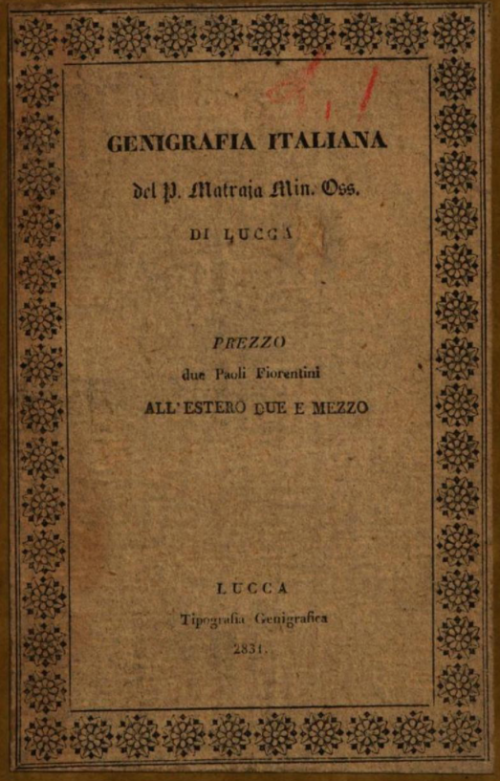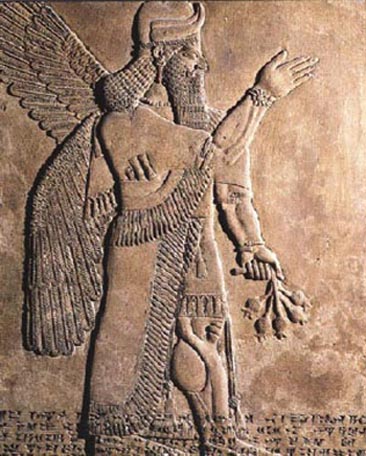Eco: The Last Flowering of Philosophic Languages, 2

Giovanni Giuseppe Matraja, Genigrafia italiana, 1831. Original held at the University of Illinois at Urbana-Champaign, with a glorious eBook format posted by the Hathitrust and GoogleBooks among others. This work is in the public domain in its country of origin and other countries and areas where the copyright term is the author’s life plus 100 years or less.
“Vismes was not the only one to fall foul of this seemingly elementary snare. In 1831 Father Giovan Giuseppe Matraja published his Genigrafia italiana, which is nothing other than a polygraphy with five (Italian) dictionaries, one for nouns, one for verbs, one for adjectives, one for interjections and one for adverbs.
Since the five dictionaries account for only 15,000 terms, Matraja adds another dictionary that lists 6,000 synonyms. His method managed to be both haphazard and laborious: Matraja divided his terms into a series of numbered classes each containing 26 terms, each marked by an alphabetical letter: thus A1 means “hatchet,” A2 means “hermit,” A1000 means “encrustation,” A360 means “sand-digger,” etc.
Even though he had served as a missionary in South America, Matraja was still convinced that all cultures used the same system of notions. He believed that western languages (all of which he seemed to imagine were derived from Latin grammar) might perfectly well serve as the basis for another language, because, by a special natural gift, all peoples used the same syntactic structures when speaking–especially American Indians.
In fact, he included a genigraphical translation of the Lord’s Prayer comparing it with versions in twelve other languages including Nahuatl, Chilean and Quechua.
In 1827 François Soudre invented the Solresol (Langue musicale universelle, 1866). Soudre was also persuaded that the seven notes of the musical scale composed an alphabet comprehensible by all the peoples of the world, because the notes are written in the same way in all languages, and could be sung, recorded on staves, represented with special stenographic signs, figured in Arabic numerals, shown with the seven colors of the spectrum, and even indicated by the touch of the fingers of the right and left hands–thus making their representation comprehensible even for the deaf, dumb and blind.
It was not necessary that these notes be based on a logical classification of ideas. A single note expresses terms such as “yes” (musical si, or B) and “no” (do, or C); two notes express pronouns (“mine” = redo, “yours” = remi); three notes express everyday words like “time” (doredo) or “day” (doremi).
The initial notes refer to an encyclopedic class. Yet Soudre also wished to express opposites by musical inversion (a nice anticipation of a twelve-tone music procedure): thus, if the idea of “God” was naturally expressed by the major chord built upon the tonic, domisol, the idea of “Satan” would have to be the inversion, solmido.
Of course, this practice makes nonsense of the rule that the first letter in a three-note term refers to an encyclopedic class: the initial do refers to the physical and moral qualities, but the initial sol refers back to arts and sciences (and to associate them with Satan would be an excess of bigotry).
Besides the obvious difficulties inherent in any a priori language, the musical language of Soudre added the additional hurdle of requiring a good ear. We seem in some way to be returning to the seventeenth century myth of the language of birds, this time with less glossolalic grace, however, and a good deal more pure classificatory pedantry.
Couturat and Leau (1903: 37) awarded to the Solresol the encomium of being “the most artificial and most impracticable of all the a priori languages.” Even its number system is inaccessible; it is based on a hexadecimal system which, despite its claims to universality, still manages to indulge in the French quirk of eliminating names for 70 and 90.
Yet Soudre labored for forty-five years to perfect his system, obtaining in the meantime testimonials from the Institut de France, from musicians such as Cherubini, from Victor Hugo, Lamartine and Alexander von Humboldt; he was received by Napoleon III; he was awarded 10,000 francs at the Exposition Universale in Paris in 1855 and the gold medal at the London Exposition of 1862.
Let us neglect for the sake of brevity the Système de langue universelle of Grosselin (1836), the Langue universelle et analytique of Vidal (1844), the Cours complet de langue universelle by Letellier (1832-55), the Blaia Zimandal of Meriggi (1884), the projects of so distinguished a philosopher as Renouvier (1885), the Lingualumina of Dyer (1875), the Langue internationale étymologique of Reimann (1877), the Langue naturelle of Maldant (1887), the Spokil of Dr. Nicolas (1900), the Zahlensprache of Hilbe (1901), the Völkerverkehrsprache of Dietrich (1902), and the Perio of Talundberg (1904).
We will content ourselves with a brief account of the Projet d’une langue universelle of Sotos Ochando (1855). Its theoretical foundations are comparatively well reasoned and motivated; its logical structure could not be of a greater simplicity and regularity; the project proposes–as usual–to establish a perfect correspondence between the order of things signified and the alphabetical order of the words that express them.
Unfortunately–here we go again–the arrangement is empirical: A refers to inorganic material things, B to the liberal arts, C to the mechanical arts, D to political society, E to living bodies, and so forth.
With the addition of the morphological rules, one generates, to use the mineral kingdom as an example, the words Ababa for oxygen, Ababe for hydrogen, Ababi for nitrogen, Ababo for sulphur.
If we consider that the numbers from one to ten are siba, sibe, sibi, sibo, sibu, sibra, sibre, sibri, sibro, and sibru (pity the poor school children having to memorize their multiplication tables), it is evident that words with analogous meanings are all going to sound the same.
This makes the discrimination of concepts almost impossible, even if the formation of names follows a criterion similar to that of chemistry, and the letters stand for the components of the concept.
The author may claim that, using his system, anyone can learn over six million words in less than an hour; yet as Couturat and Leau remark (1903: 69), learning a system that can generate six million words in an hour is not the same as memorizing, recognizing, six million meanings.
The list could be continued, yet towards the end of the nineteenth century, news of the invention of a priori languages was becoming less a matter for scientific communications and more one for reports on eccentric fellows–from Les fous littéraires by Brunet in 1880 to Les fous littéraires by Blavier in 1982.
By now, the invention of a priori languages, other than being the special province of visionaries of all lands, had become a game (see Bausani 1970 and his language Markuska) or a literary exercise (see Yaguello 1984 and Giovannoli 1990 for the imaginary languages of science fiction).
Umberto Eco, The Search for the Perfect Language, translated by James Fentress, Blackwell. Oxford, 1995, pp. 305-8.





